Page 540 of 579
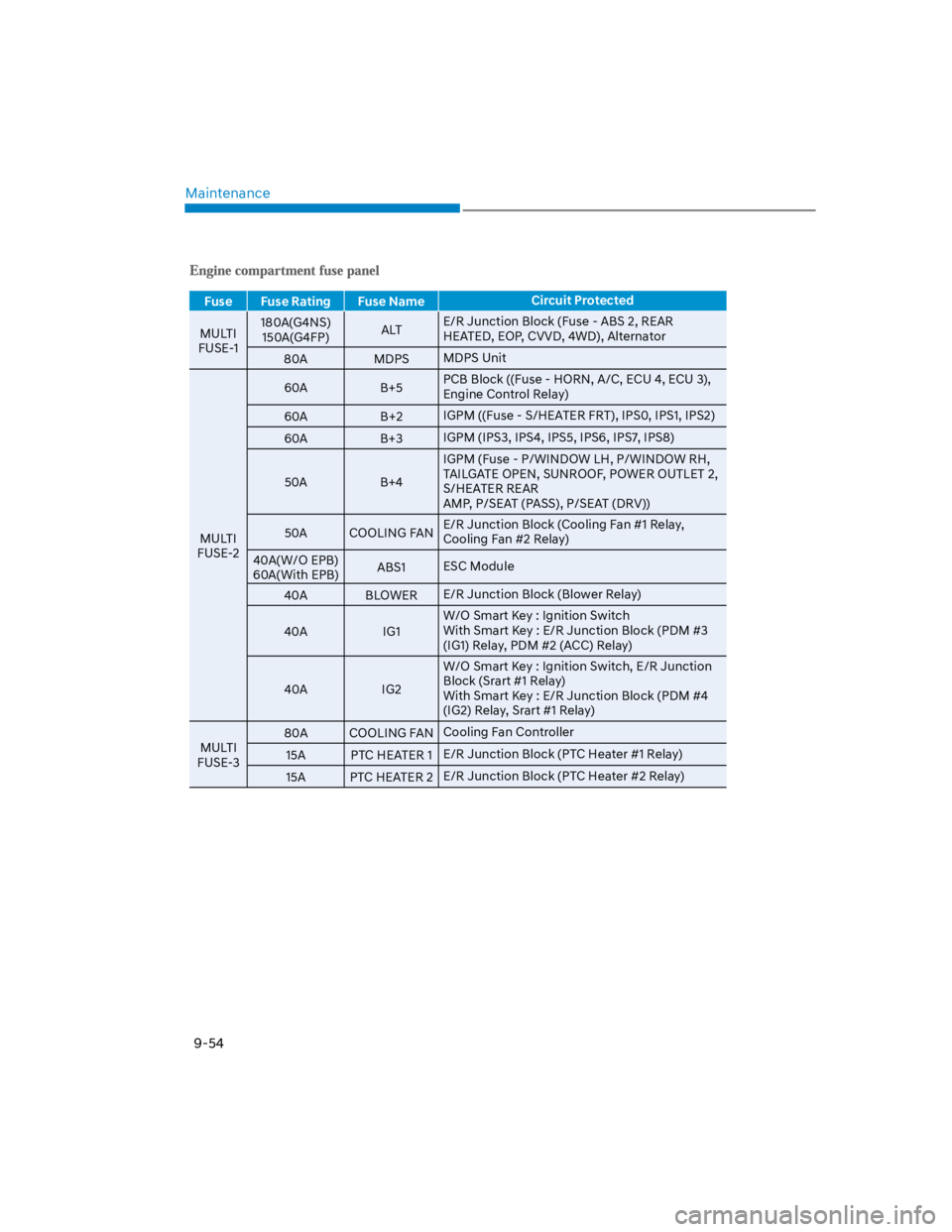
Maintenance
9-54
Fuse Fuse Rating Fuse NameCircuit Protected
MULTI
FUSE-1
180A(G4NS)
150A(G4FP)ALTE/R Junction Block (Fuse - ABS 2, REAR
HEATED, EOP, CVVD, 4WD), Alternator
80A MDPSMDPS Unit
MULTI
FUSE-2
60A B+5PCB Block ((Fuse - HORN, A/C, ECU 4, ECU 3),
Engine Control Relay)
60A B+2IGPM ((Fuse - S/HEATER FRT), IPS0, IPS1, IPS2)
60A B+3IGPM (IPS3, IPS4, IPS5, IPS6, IPS7, IPS8)
50A B+4
IGPM (Fuse - P/WINDOW LH, P/WINDOW RH,
TAILGATE OPEN, SUNROOF, POWER OUTLET 2,
S/HEATER REAR
AMP, P/SEAT (PASS), P/SEAT (DRV))
50A COOLING FANE/R Junction Block (Cooling Fan #1 Relay,
Cooling Fan #2 Relay)
40A(W/O EPB)
60A(With EPB)ABS1ESC Module
40A BLOWERE/R Junction Block (Blower Relay)
40A IG1
W/O Smart Key : Ignition Switch
With Smart Key : E/R Junction Block (PDM #3
(IG1) Relay, PDM #2 (ACC) Relay)
40A IG2
W/O Smart Key : Ignition Switch, E/R Junction
Block (Srart #1 Relay)
With Smart Key : E/R Junction Block (PDM #4
(IG2) Relay, Srart #1 Relay)
MULTI
FUSE-3
80A COOLING FANCooling Fan Controller
15A PTC HEATER 1E/R Junction Block (PTC Heater #1 Relay)
15A PTC HEATER 2E/R Junction Block (PTC Heater #2 Relay)
Page 542 of 579
Maintenance
9-56
Fuse NameFuse Rating Circuit Protected
SENSOR210A
PCB Block (A/C Comp Relay), Variable Oil Pump Solenoid,
Purge Control Solenoid Valve, RCV Control Solenoid Valve,
Oil Control Valve #1 (Intake), Oil Control Valve #2 (Exhaust),
Canister Close Valve
ECU210A ECM
ECU120A ECM
INJECTOR15A -
SENSOR115A Oxygen Sensor (Up), Oxygen Sensor (Down)
IGN COIL20A Ignition Coil #1~#4
ECU315A ECM
A/C10A PCB Block (A/C Comp Relay)
ECU510A ECM, CVVD Actuator
SENSOR415A -
ABS310A ESC Module, Multipurpose Check Connector
TCU215A TCM, Transaxle Range Switch
SENSOR310A E/R Junction Block (Fuel Pump Relay)
ECU415A ECM
HORN15A PCB Block (Horn Relay)
Page 544 of 579
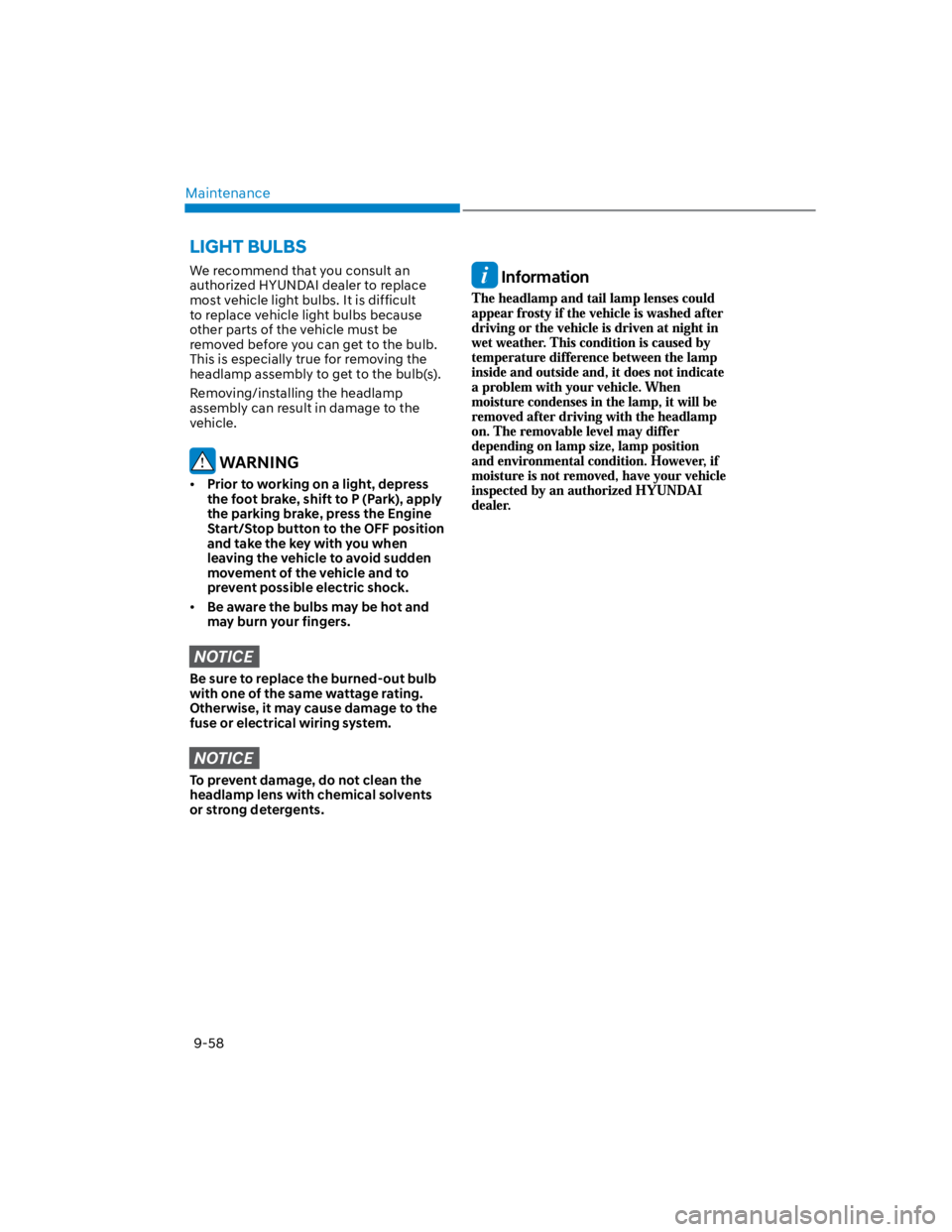
Maintenance
9-58
We recommend that you consult an
authorized HYUNDAI dealer to replace
most vehicle light bulbs. It is difficult
to replace vehicle light bulbs because
other parts of the vehicle must be
removed before you can get to the bulb.
This is especially true for removing the
headlamp assembly to get to the bulb(s).
Removing/installing the headlamp
assembly can result in damage to the
vehicle.
WARNING
Prior to working on a light, depress
the foot brake, shift to P (Park), apply
the parking brake, press the Engine
Start/Stop button to the OFF position
and take the key with you when
leaving the vehicle to avoid sudden
movement of the vehicle and to
prevent possible electric shock.
Be aware the bulbs may be hot and
may burn your fingers.
NOTICE
Be sure to replace the burned-out bulb
with one of the same wattage rating.
Otherwise, it may cause damage to the
fuse or electrical wiring system.
NOTICE
To prevent damage, do not clean the
headlamp lens with chemical solvents
or strong detergents.
Information
LIGHT BULBS
Page 546 of 579
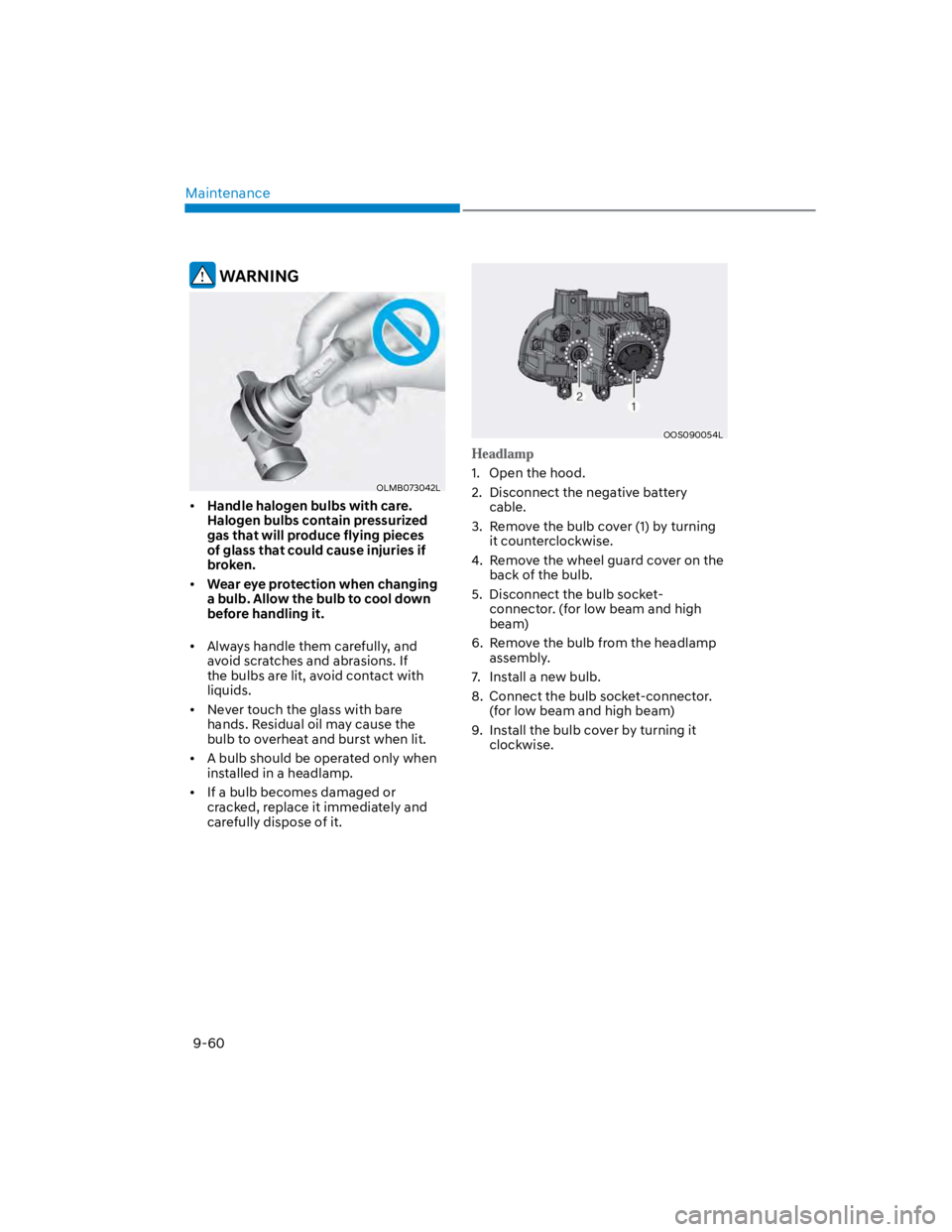
Maintenance
9-60
WARNING
OLMB073042L
Handle halogen bulbs with care.
Halogen bulbs contain pressurized
gas that will produce flying pieces
of glass that could cause injuries if
broken.
Wear eye protection when changing
a bulb. Allow the bulb to cool down
before handling it.
Always handle them carefully, and
avoid scratches and abrasions. If
the bulbs are lit, avoid contact with
liquids.
Never touch the glass with bare
hands. Residual oil may cause the
bulb to overheat and burst when lit.
A bulb should be operated only when
installed in a headlamp.
If a bulb becomes damaged or
cracked, replace it immediately and
carefully dispose of it.
OOS090054L
1. Open the hood.
2. Disconnect the negative battery
cable.
3. Remove the bulb cover (1) by turning
it counterclockwise.
4. Remove the wheel guard cover on the
back of the bulb.
5. Disconnect the bulb socket-
connector. (for low beam and high
beam)
6. Remove the bulb from the headlamp
assembly.
7. Install a new bulb.
8. Connect the bulb socket-connector.
(for low beam and high beam)
9. Install the bulb cover by turning it
clockwise.
Page 548 of 579
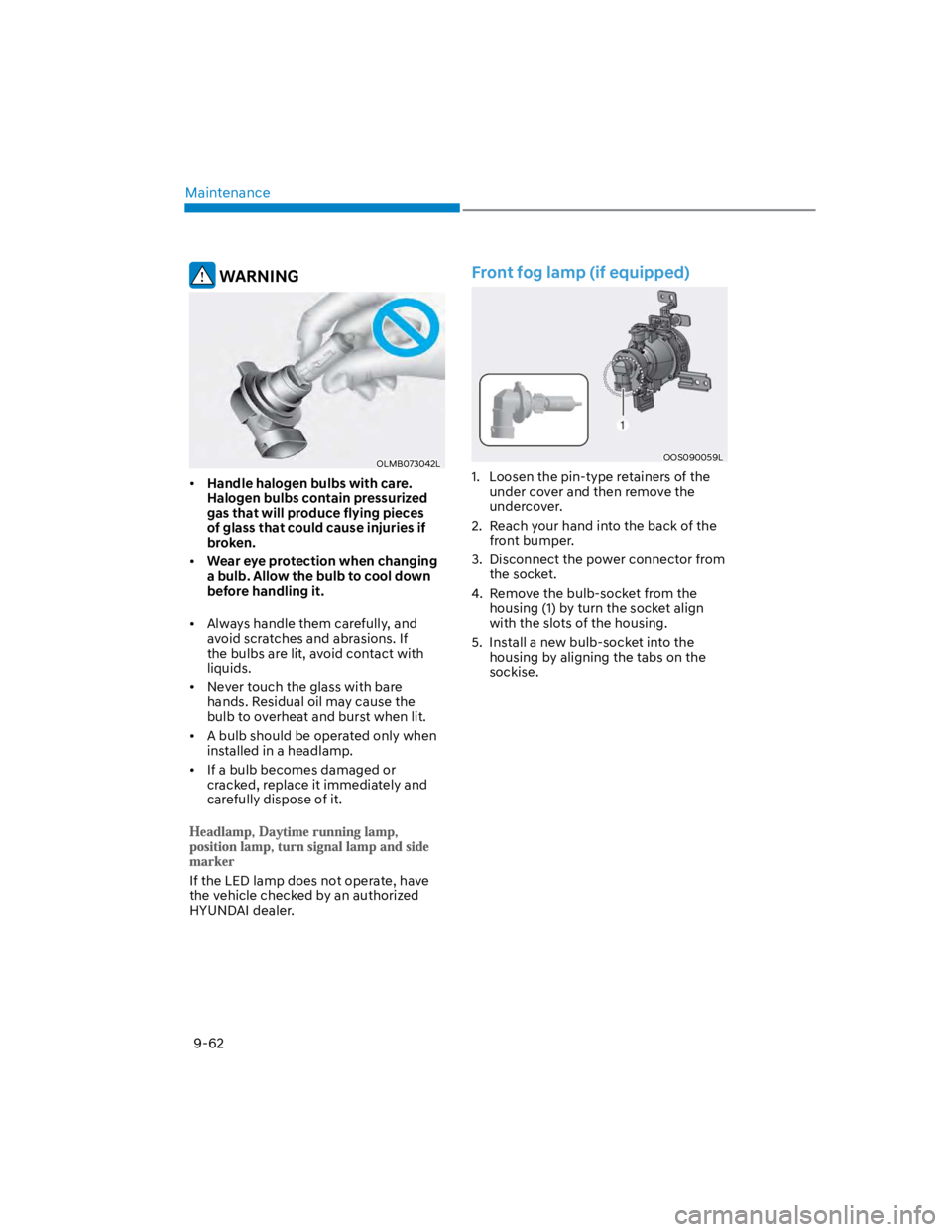
Maintenance
9-62
WARNING
OLMB073042L
Handle halogen bulbs with care.
Halogen bulbs contain pressurized
gas that will produce flying pieces
of glass that could cause injuries if
broken.
Wear eye protection when changing
a bulb. Allow the bulb to cool down
before handling it.
Always handle them carefully, and
avoid scratches and abrasions. If
the bulbs are lit, avoid contact with
liquids.
Never touch the glass with bare
hands. Residual oil may cause the
bulb to overheat and burst when lit.
A bulb should be operated only when
installed in a headlamp.
If a bulb becomes damaged or
cracked, replace it immediately and
carefully dispose of it.
If the LED lamp does not operate, have
the vehicle checked by an authorized
HYUNDAI dealer.
Front fog lamp (if equipped)
OOS090059L
1. Loosen the pin-type retainers of the
under cover and then remove the
undercover.
2. Reach your hand into the back of the
front bumper.
3. Disconnect the power connector from
the socket.
4. Remove the bulb-socket from the
housing (1) by turn the socket align
with the slots of the housing.
5. Install a new bulb-socket into the
housing by aligning the tabs on the
sockise.
Page 550 of 579
Maintenance
9-64
OOS077066L
1. Turn off the engine.
2. Open the tailgate.
3. Loosen the lamp assembly retaining
screws with a cross-tip screwdriver.
OOS077068L
4. Remove the rear combination lamp
assembly from the body of the
vehicle.
5. Remove the socket from the
assembly by turning the socket
counterclockwise until the tabs on
the socket align with the slots on the
assembly.
6. Remove the bulb from the socket
by pressing it in and rotating it
counterclockwise until the tabs on the
bulb align with the slots in the socket.
Pull the bulb out of the socket.
7. Insert a new bulb by inserting it into
the socket and rotating it until it locks
into place.
8. Install the socket into the assembly by
aligning the tabs on the socket with
the slots in the assembly. Push the
socket into the assembly and turn the
socket clockwise.
9. 9. Reinstall the lamp assembly to the
body of the vehicle.
Page 552 of 579
Maintenance
9-66
License Plate Light Bulb
Replacement
OOS077043
1. Using a flat-blade screwdriver, gently
pry the lens cover from the lamp
housing.
2. Remove the bulb by pulling it straight
out.
3. Install a new bulb.
4. Reinstall in the reverse order.
Interior Light Bulb Replacement
Map lamp, Room lamp, Vanity mirror
lamp, Luggage compartment lamp
and Glove box lamp
Map lamp (Type A)
OOS077053
Map lamp (Type B)
OOS077044
Page 554 of 579
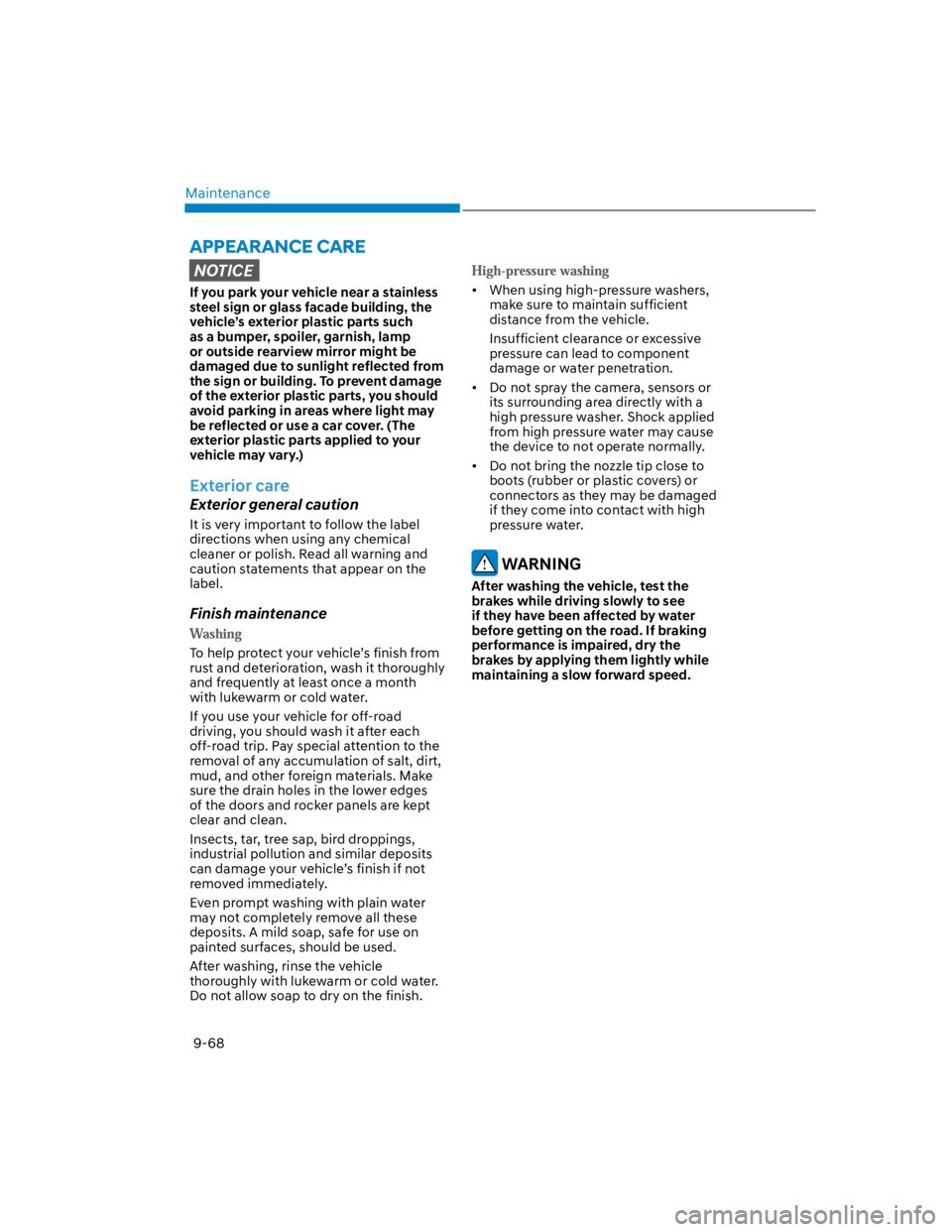
Maintenance
9-68
NOTICE
If you park your vehicle near a stainless
steel sign or glass facade building, the
vehicle’s exterior plastic parts such
as a bumper, spoiler, garnish, lamp
or outside rearview mirror might be
damaged due to sunlight reflected from
the sign or building. To prevent damage
of the exterior plastic parts, you should
avoid parking in areas where light may
be reflected or use a car cover. (The
exterior plastic parts applied to your
vehicle may vary.)
Exterior care
Exterior general caution
It is very important to follow the label
directions when using any chemical
cleaner or polish. Read all warning and
caution statements that appear on the
label.
Finish maintenance
To help protect your vehicle’s finish from
rust and deterioration, wash it thoroughly
and frequently at least once a month
with lukewarm or cold water.
If you use your vehicle for off-road
driving, you should wash it after each
off-road trip. Pay special attention to the
removal of any accumulation of salt, dirt,
mud, and other foreign materials. Make
sure the drain holes in the lower edges
of the doors and rocker panels are kept
clear and clean.
Insects, tar, tree sap, bird droppings,
industrial pollution and similar deposits
can damage your vehicle’s finish if not
removed immediately.
Even prompt washing with plain water
may not completely remove all these
deposits. A mild soap, safe for use on
painted surfaces, should be used.
After washing, rinse the vehicle
thoroughly with lukewarm or cold water.
Do not allow soap to dry on the finish.
When using high-pressure washers,
make sure to maintain sufficient
distance from the vehicle.
Insufficient clearance or excessive
pressure can lead to component
damage or water penetration.
Do not spray the camera, sensors or
its surrounding area directly with a
high pressure washer. Shock applied
from high pressure water may cause
the device to not operate normally.
Do not bring the nozzle tip close to
boots (rubber or plastic covers) or
connectors as they may be damaged
if they come into contact with high
pressure water.
WARNING
After washing the vehicle, test the
brakes while driving slowly to see
if they have been affected by water
before getting on the road. If braking
performance is impaired, dry the
brakes by applying them lightly while
maintaining a slow forward speed.
APPEARANCE CARE